Difference between revisions of "Agar"
(Save Early and Often!) |
m |
||
| (22 intermediate revisions by 10 users not shown) | |||
| Line 1: | Line 1: | ||
{{Glossary}} | {{Glossary}} | ||
An '''agar''' is any pattern covering the whole plane that is periodic in both space and time. In other words, they are the shift periodic configurations contemplated | An '''agar''' is any pattern covering the whole plane that is periodic in both space and time. In other words, they are the shift periodic configurations contemplated by symbolic dynamical systems theory, although this characterization is not always followed rigorously. Low entropy and a semblance of order is the real criterion; there are several possibilities: | ||
* strict periodicity according to a compatible lattice group, | |||
* degenerate one dimensional periodicity ([[ripples]]), | |||
* symmetry arising from a second stage de Bruijn diagram, | |||
* color symmetry following a Shubnikov group, | |||
* irregular with the symmetry of a superlattice, | |||
* fractal symmetry described by a [[Lindenmayer systems|Lindenmayer system]], or | |||
* they just look pretty. | |||
Any set of bounded patterns may be laid side by side, provided that they are sufficiently separated, and still not be seen as an agar. For example, that is the difference between still lifes and pseudo still lifes. As a restricted class of Life patterns, agars often subject to mathematical or computational analysis. If they were much more arbitrary, they would be called [[soup|soups]] or [[ash]]. | |||
The following tables show examples of linear and tiling agars. Refer to each link for building methods and more variations than may be shown here. | The following tables show examples of linear and tiling agars. Refer to each link for building methods and more variations than may be shown here. | ||
| Line 12: | Line 16: | ||
== Line agars == | == Line agars == | ||
{| class="wikitable" style="margin-left:auto;margin-right:auto;" | {| class="wikitable" style="margin-left:auto;margin-right:auto;" | ||
!Agar !! density !! [[period]] !! stable !!notes !! image | !Agar !! [[density]] !! [[period]] !! stable !!notes !! image | ||
|- | |- | ||
|[[Zebra stripes]] || 1/2 || - || B (1)||alternating bands of live and unoccupied cells (ripples(2)) ||[[Image:LINEZB.GIF]] | |[[Zebra stripes]] || 1/2 || - || B (1)||alternating bands of live and unoccupied cells (ripples(2)) ||[[Image:LINEZB.GIF]] | ||
| Line 18: | Line 22: | ||
|[[Venetian blinds]] || 1/2 || 2 || B ||phoenix made of fat ripples, varying only longitudinally (2) ||[[Image:LINEVB.GIF]] | |[[Venetian blinds]] || 1/2 || 2 || B ||phoenix made of fat ripples, varying only longitudinally (2) ||[[Image:LINEVB.GIF]] | ||
|- | |- | ||
|[[Chicken wire]] || 1/2 || 2 || B ||''wires'' | |[[Chicken wire]] || 1/2 || 2 || B ||''wires'' have a uniform height of 2 but with gaps at least 2 cells wide||[[Image:LINECW.GIF]] | ||
|- | |- | ||
|Diagonal [[ripples]] || 7/20 || - || S || | |Diagonal [[ripples]] || 7/20 || - || S ||diagonal strands which can occur singly, in pairs or mixtures separated by at least two cells. Transient evolution eventually comes to rest periodically, including vanishing||[[Image:LINEDG.GIF]] | ||
|- | |- | ||
|Phoenix || - || 2 || ||filaments can be separated, and possibly terminated as barberpoles ||[[Image:LINEPH.GIF]] | |Phoenix || - || 2 || ||the avatar filaments can be separated, and possibly terminated as barberpoles ||[[Image:LINEPH.GIF]] | ||
|} | |} | ||
# S, stable ; B, must be bound on two or four sides ; for common bounds see [[Dean Hickerson]]'s list<ref>{{CiteHickersonOscillators}}</ref>. | # S, stable ; B, must be bound on two or four sides ; for common bounds see [[Dean Hickerson]]'s list<ref>{{CiteHickersonOscillators}}</ref>. | ||
# Cross sections following [[Stephen Wolfram|Wolfram]]'s [[Rule 22]]. | # Cross sections following [[Stephen Wolfram|Wolfram]]'s (2,1) [[Rule 22]]. | ||
# Cross sections following [[Stephen Wolfram|Wolfram]]'s (2,2) Rule 01140238X | |||
== | == Tile agars == | ||
{| class="wikitable" style="margin-left:auto;margin-right:auto;" | {| class="wikitable" style="margin-left:auto;margin-right:auto;" | ||
!Agar !! tile size !! [[bounding box|box]] !! density !! period !! stable !!notes | !Agar !! tile size !! [[bounding box|box]] !! density !! period !! stable !!notes !!Image showing unit cell and 2x2 cell | ||
|- | |- | ||
|[[Onion rings]] || 72 || 12*12 || 1/2 || || B ||unit cell composed of nested squares (4n | |[[Onion rings]] || 72 || 12*12 || 1/2 || || B ||unit cell composed of nested squares (4n×4n) ; static on a color lattice (complementary sublattices alternate checkerboardwise)||[[Image:TILEOR.GIF]] | ||
|- | |- | ||
|[[Marshland agar]] || 4 || 3*3 || 4/9 || || S || | |[[Marshland agar]] || 4 || 3*3 || 4/9 || || S ||built from [[pond]]s and [[lake]]s, that is, dominoes ; of many possible combinations, only basic ones go squared ||[[Image:TILEML.GIF]] | ||
|- | |- | ||
|[[Houndstooth agar]] || 8 || 4*4 || 1/2 || 2 || B ||really the pattern of a known checquered twill | |[[Houndstooth agar]] || 8 || 4*4 || 1/2 || 2 || B ||really the pattern of a known checquered [[twill]] ||[[Image:TILEHO.GIF]] | ||
|- | |- | ||
|[[Herparian agar]] || 12 || 6*6 || 1/3 || || S ||lakes made of [[snake]]s acting like | |[[Herparian agar]] || 12 || 6*6 || 1/3 || || S ||lakes made of [[snake]]s acting like dominoes ; only the most basic give a ''square'' tiling ||[[Image:TILEHA.GIF]] | ||
|- | |- | ||
|[[Squaredance]] || 8 || 6*6 || 2/9 || 2 || B ||period 2 diagonal agar and [[phoenix]], low density | |[[Herparian agar]] || 12 || 6*6 || 1/3 || || S ||snakes polymerize in three ways; the unit cell of this agar is oblong ||[[Image:TILEHB.GIF]] | ||
|- | |||
|[[Squaredance]] || 8 || 6*6 || 2/9 || 2 || B ||period 2 diagonal agar and [[phoenix]], low density domino pattern ||[[Image:TILESD.GIF]] | |||
|- | |||
|Scrubber/Piston || || || || 2 || B ||period 2; odd generations = [[Piston]] (or [[Spark coil]]), even generations = [[Scrubber]] ||[[Image:TILEPS.GIF]] | |||
|- | |||
|[[Reciprocating agar]] || || || || 2 || B ||period 2; [[Test tube baby]] can be elongated, rotated, stabilized, to get numerous tiles. Packable regularly or irregularly into the cartesian plane, none is necessarily a unit cell. || [[Image:RCPAAGR.GIF]] | |||
|} | |} | ||
Revision as of 05:25, 30 December 2019
An agar is any pattern covering the whole plane that is periodic in both space and time. In other words, they are the shift periodic configurations contemplated by symbolic dynamical systems theory, although this characterization is not always followed rigorously. Low entropy and a semblance of order is the real criterion; there are several possibilities:
- strict periodicity according to a compatible lattice group,
- degenerate one dimensional periodicity (ripples),
- symmetry arising from a second stage de Bruijn diagram,
- color symmetry following a Shubnikov group,
- irregular with the symmetry of a superlattice,
- fractal symmetry described by a Lindenmayer system, or
- they just look pretty.
Any set of bounded patterns may be laid side by side, provided that they are sufficiently separated, and still not be seen as an agar. For example, that is the difference between still lifes and pseudo still lifes. As a restricted class of Life patterns, agars often subject to mathematical or computational analysis. If they were much more arbitrary, they would be called soups or ash.
The following tables show examples of linear and tiling agars. Refer to each link for building methods and more variations than may be shown here.
Line agars
| Agar | density | period | stable | notes | image |
|---|---|---|---|---|---|
| Zebra stripes | 1/2 | - | B (1) | alternating bands of live and unoccupied cells (ripples(2)) | 
|
| Venetian blinds | 1/2 | 2 | B | phoenix made of fat ripples, varying only longitudinally (2) | 
|
| Chicken wire | 1/2 | 2 | B | wires have a uniform height of 2 but with gaps at least 2 cells wide | 
|
| Diagonal ripples | 7/20 | - | S | diagonal strands which can occur singly, in pairs or mixtures separated by at least two cells. Transient evolution eventually comes to rest periodically, including vanishing | 
|
| Phoenix | - | 2 | the avatar filaments can be separated, and possibly terminated as barberpoles | 
|
- S, stable ; B, must be bound on two or four sides ; for common bounds see Dean Hickerson's list[1].
- Cross sections following Wolfram's (2,1) Rule 22.
- Cross sections following Wolfram's (2,2) Rule 01140238X
Tile agars
| Agar | tile size | box | density | period | stable | notes | Image showing unit cell and 2x2 cell |
|---|---|---|---|---|---|---|---|
| Onion rings | 72 | 12*12 | 1/2 | B | unit cell composed of nested squares (4n×4n) ; static on a color lattice (complementary sublattices alternate checkerboardwise) | 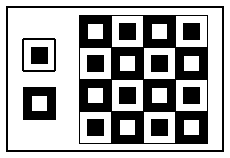
| |
| Marshland agar | 4 | 3*3 | 4/9 | S | built from ponds and lakes, that is, dominoes ; of many possible combinations, only basic ones go squared | 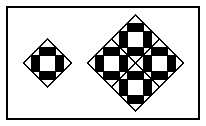
| |
| Houndstooth agar | 8 | 4*4 | 1/2 | 2 | B | really the pattern of a known checquered twill | 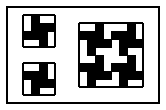
|
| Herparian agar | 12 | 6*6 | 1/3 | S | lakes made of snakes acting like dominoes ; only the most basic give a square tiling | 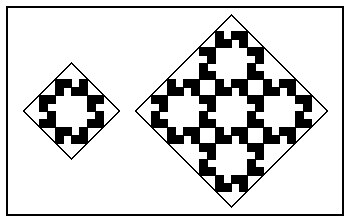
| |
| Herparian agar | 12 | 6*6 | 1/3 | S | snakes polymerize in three ways; the unit cell of this agar is oblong | 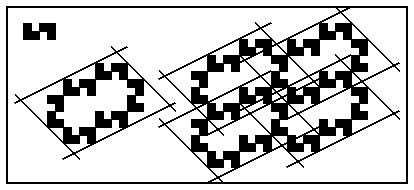
| |
| Squaredance | 8 | 6*6 | 2/9 | 2 | B | period 2 diagonal agar and phoenix, low density domino pattern | 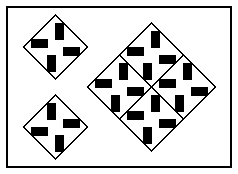
|
| Scrubber/Piston | 2 | B | period 2; odd generations = Piston (or Spark coil), even generations = Scrubber | 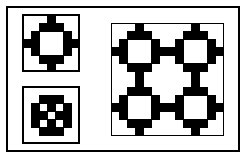
| |||
| Reciprocating agar | 2 | B | period 2; Test tube baby can be elongated, rotated, stabilized, to get numerous tiles. Packable regularly or irregularly into the cartesian plane, none is necessarily a unit cell. | 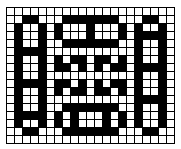
|
References
See also
External links
- Agar at the Life Lexicon